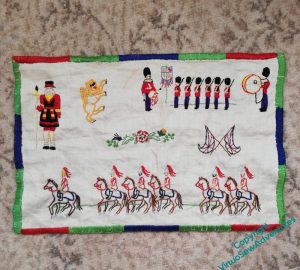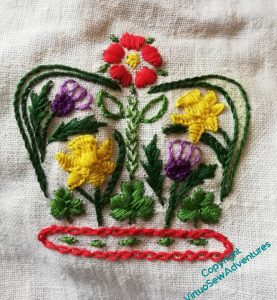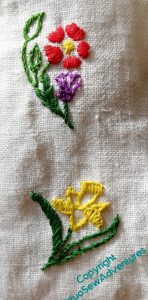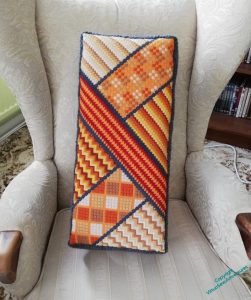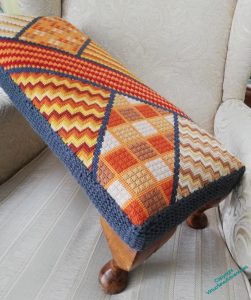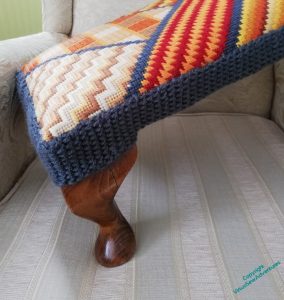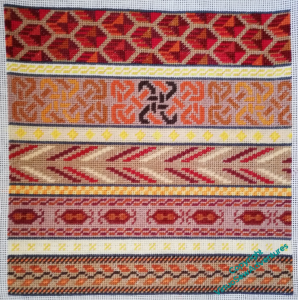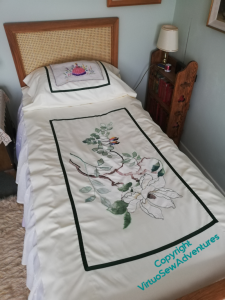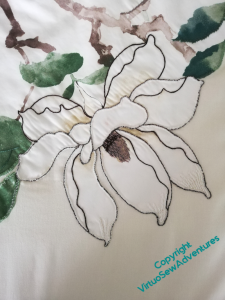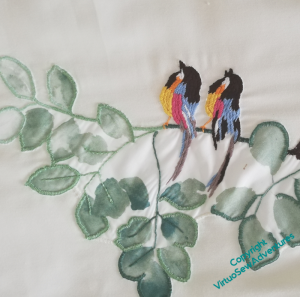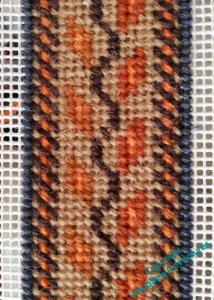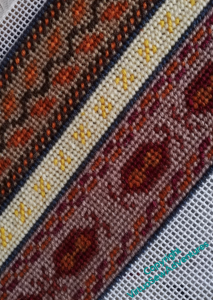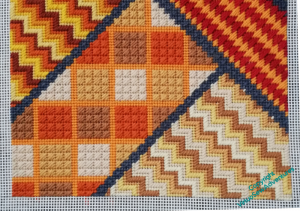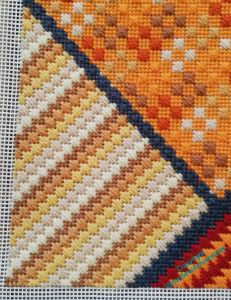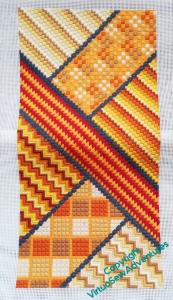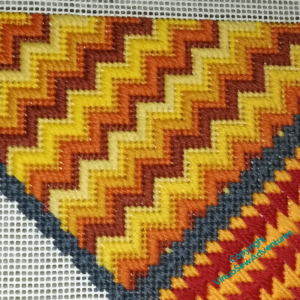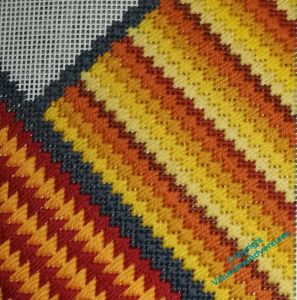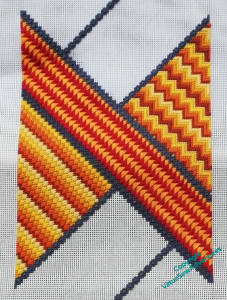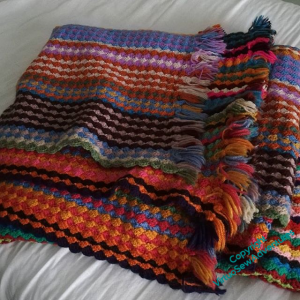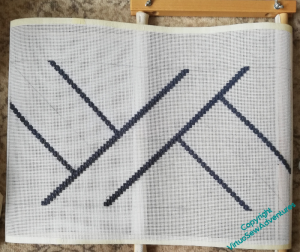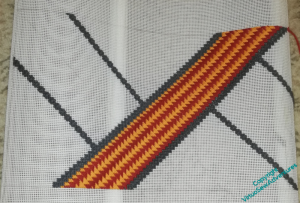Tag: embroidery for interior decoration
Coronation Stitchery
Since I did, in fact, manage to finish the traycloth I found half-begun, which I believe was designed for the late Queen’s Coronation in 1953, within her reign (if only by a few weeks), I thought I should do something in stitchery to commemorate the Coronation of King Charles III.
Nothing of the quality of those beautiful screens, or any of the other stitching (I can’t have been the only person muttering, “I want to hear more about the embroidery!”), but something simple, embroidery in the hand, like this traycloth, a return to my stitching roots.
I’ve not really had the time, or the ideas, frankly (too much else cluttering up the “designs” part of my head!) to develop anything of my own, but since the Palace had gone to the trouble of creating a rather charming Coronation logo, making use of the heraldic flowers of the United Kingdom to bring together the nations, and the King’s well-known love for the natural world, I decided to take elements from that, and put them together into a traycloth or runner.
The crown is in the centre of one short side, and I’ll put His Majesty’s cipher at the other end.
The long sides are going to be decorated with more elements from the Coronation logo. It’s all very simple stitchery, but it has been an excellent companion to the Coronation itself, and to Patrick Grant’s wonderful documentary about Kashket’s, Hainsworth’s, and the other companies involved in making elements for the Coronation.
That documentary made me positively homesick for my postgraduate days, visiting spinning mills in Lancashire and Yorkshire, surrounded by the smell of wool, and the passion and dedication of the people working in the mills. It’s an odd thing, but I’ve never met a cynic in the textile industry. People who are anxious about the future, yes, concerned about loss of skills, yes. But none of them pretend not to care, and if you show any interest, their eyes light up, and soon you are engulfed in a great flood of enthusiasm, knowledge and ideas.
Yes, I know what people say about dour Yorkshiremen. That wasn’t my experience of them, not at all!
Footstool finished and set up
There was something of a pause once I’d finished the cavaswork and we had removed the old cover from the little footstool. We reinstated all the padding (leaving my Grandad’s old pyjamas just where Grandmama had left them!) and stapled the cavaswork over the top.
However, that left a border of bare canvas, which was definitely not what I wanted on show, so there was some thought expended. There wasn’t enough of the assorted tapestry wools left over to make a border, and this was in progress during one of our lockdowns, so I couldn’t go frolicking off to a haberdashery to hunt for a braid. Very well, we would have to find a way of ensuring that our border matched, while trusting someone else to pick the material.
Fortunately, the threads I used were most of them current colours, and in particular the grey is a familiar Anchor colour. So it occurred to me that if I could find a shop that sold both embroidery supplies and knitting supplies, we could ask for a knitting wool to match the grey thread, and crochet a border.
That would have the advantage that we could be sure it would be wide enough to do the job, and in any case it could be slightly stretched to fit. I do like it when absolute millimetre precision isn’t necessary. This was a stash-busting, domestic area-improving project, not a major epic (although, you know, subject to my usual feature-creep!).
In the end, we picked a Tunisian Crochet stitch, and my Mam solemnly crocheted the necessary metre and a half of border, ten stitches wide, and then attached it.
No canvas showing now, and the knitting wool is such a perfect match you could be forgiven for thinking that we’d been intending this from the start!
Finishing the Stash Busting Cushion
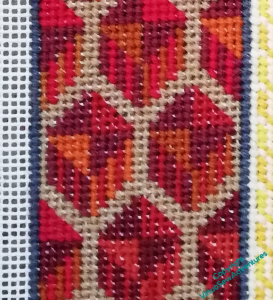
Remember this? Remember how suprised I was at just how much I was enjoying canvaswork?
I found the last pattern in “Victorian Needlepoint” by Freda Parker, another one inherited in a bundle. I keep meaning to have a good rummage in that bookshelf, and work out what I want to keep, but as it is, it makes a good resouce when I’m looking for “something, I don’t know what, but I will know it when I see it”.
Since I’m stash busting, I used several different skein remnants for each colour on the chart, so the pattern has more variety than drawn. There are three shades in the very darkest sections, and I was surprised by how little difference two of them showed once they were stitched. You learn things at the oddest times.
That panel is the last, by the way, because at this point I ran out of canvas!
It does, however, make a squarish, ornamental panel. If I can find some suitable fabric, I can give it a backing and turn it into a cushion.
Episode 52 of SlowTV Stitchery is now live, in which I challenge you all to name some works of fiction in which needlework has a prominent and positive role…
Continuing the stash busting cushion
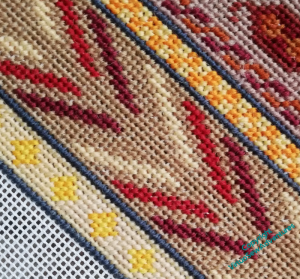
The second, simpler version of the stripes works better – much better. I like the deepening colours, and the change of spacing creates a changing rhythm.
The next band uses three different yellows to make little diamond shapes, alternating darks and lights – although as the darks and lights looked closer togther when stitched than on the hank, the alternations don’t show as much as I thought they would!
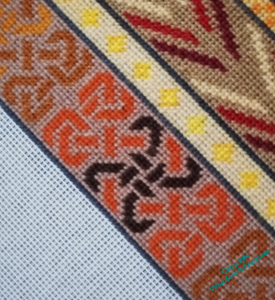
I became a little ambitious after that, and found a celtic knotwork pattern in a book (Celtic Needlepoint, by Alice Starmore) I inherited with a bundle of other things from a local lady who seems to have been as adventurous with her needle as I am, but with a greater emphasis on counted work.
I went astray a couple of times. Knotwork patterns are a little taxing!
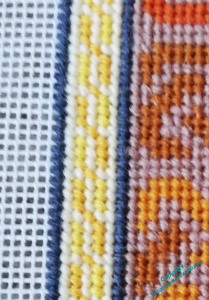
I hadn’t quite recovered from tyeing myself in knots when I did the next narrow band. This was intended to be a chain link pattern, but I ended up with something else – what, I’m not quite sure!
The next Episode of #SlowTVStitchery is now live – remembering the agony of unpicking Akhenaten’s seat, while considering the question of the right style of detail to add to a design, with particular reference to the Christmas Angel.
A Finish To Celebrate (not mine!)
You may recall that my mother was embroidering details and edgings on an appliqu bedcover for herself.
It’s finished!
The slightly more marked colours and edgings make sense of it as a response to the curtains, rather than a random slice of curtain material, and the crisp green ribbon frame confines and sets it off rather nicely.
She occasionally asked for my advice, but I can’t say she needed it. This is the only point, I think, at which I made a material contribution to the finished piece. The fabric was lamentably keen to fray, so all raw edges needed covering, and this large flower would have looked very clunky with dark blanket stitch.
White blanket stitch, whipped along the outside edge, however – that worked!
The stitching for the birds was inspired by something Grandmama did, and does look quite feathery, somehow.
It’s always satisfying when a plan comes together, even when it isn’t one of mine!
Returning to my projects, however, Episode 46 of Slow TV Stitchery is now live, in which are discussed the Delights of Stash and the Perils of OverEngineering.
More Stash Busting
In the clearest demonstration yet – at least in embroidery terms – that we are in the End Times, I have embarked on some stash busting counted tent stitch.
I rather enjoyed working on the Stash Busting Footstool, and there was a bit of canvas left on the frame when I’d made it, so I reattached the cut end, rifled through what was left of the tapestry wool, and started to play.
Since I don’t know how far my wools will stretch, my sole “design” is to take the idea of making a fabric from ornamental ribbons, alternating broad and narrow.
This vine pattern is based on one in “Needlepoint” from Ebury Press.
The next two “ribbons” I made up as I went along – one narrow, light pattern in two shades of yellow, and another broad one, this one distinctly made-up-as-I-went-along. It was very vaguely inspired by another in “Needlepoint”, which in turn claimed to be inspired by a Persian pattern. I have my doubts, but in any case, even when I tried to have a sensible pattern of spacing, I ended up with something of a mishmash.
You may have noticed that the “neutral” in the two broad stripes is not the same colour. I’m going to try to alternate these as backgrounds, unless and until I start to need to blend them together to fill the space.
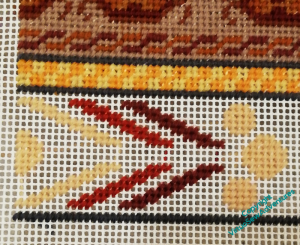
The next, narrow, band, is a chequerboard.
I like the stripe part of this next pattern, but after working the baubles, I looked again and decided that they weren’t quite working. I was trying for a mix of shapes, a bit of variety, and something to change the spacing of the stripes, but not this!
And while you assimilate the shock of me happily doing counted work – Episode 44 of Slow TV Stitchery is now live. In which we discuss the EES as an early crowd-funded organisation, my ambitions to hold a Dreams of Amarna exhibition, and whether “medieval muddle” is an idea purely from 19th Century northern Europe.
The Stash Busting Footstool, 4
After a bit of thought and discussion, my mother suggested that for the last two panels, I should consider doing the same as on the far side of the central panel, but in a different set of colours. I had wanted to lighten the colours as they came away from the central panel, so that’s the scheme I used to pick the colours.
That, and making sure that I thought I would have enough of each colour to do both panels!
I then made things slightly harder for myself by deciding to line up the stripes across the central panels, but it was definitely worth doing. As I’ve said before, when upcycling, mending, or dealing with slightly not-entirely-planned projects, the whole secret is to make it all look deliberately planned – that’s why my mending tends to be embellished in a variety of ways.
Here is the finished canvaswork.
Actually, it isn’t. When I took it off the frame and took it to meet the footstool it’s intended for, I found it was an inch too short, in spite of what I believed to have been some careful measuring.
Clearly not careful enough!
I’m going to add half an inch to each end, and then consider the next step!
In other news, Episode 42 of Slow TV Stitchery is now live. In which I think I may have got to grips with the pattern, consider the adventures of Sir John de Mandeville, and consider the question of Music To Stitch To…
Stash Busting Canvaswork Footstool – 3
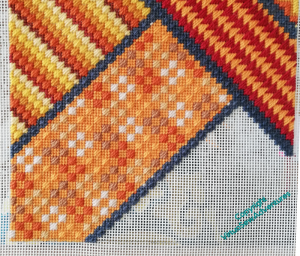
The notion that was guiding me – apart from stash busting – was of the colours getting lighter as they spiral out from the central point on either side of the central bar. So I picked more colours that I had enough of (see the constant balancing act I was involved in here?), and this time, stitch patterns which were squarish, rather than stripy. This is Checquer Stitch, and somehow by the time I’d finished the alternation of the colours, I ended up with something that rather reminded me of a Welsh Tapestry blanket. I’m happy with that – I was born in Wales, after all!
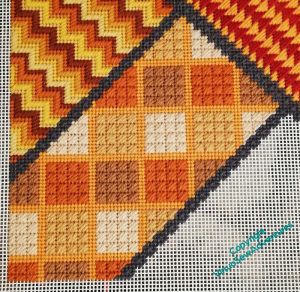
The balancing panel is even squarer. I suppose it is another variant – rather as with the Moorish Stitch Variation, I’ve moved all the tent stitches to the edges to form a grid. I think it still has enough family resemblence both to the original stitch and to the “Welsh Tapestry” version to balance them.
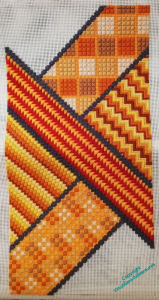
So here is stage two completed.
I think the balance and harmony I’m trying to create really are still there, but I feel as though I’ve rather shot my bolt. I’ve mislaid my canvaswork books and I can’t think of another suitable pair of diagonal stitches to use.
However, the first thing to do is to find a suitable set of colours. Onward, ever onward!
In the meantime, Epsiode 41 of SlowTV Stitchery is now live. A fairly quiet episode, this, which nonetheless discusses musical deceleration and taking refuge in learning things, while also anticipating the enjoyment of a Holiday Project.
Stash Busting Canvaswork Footstool -2
As this is a strictly stash-busting exercise, and I wanted to balance the colours across the central bar, I started by finding the colours I had two skeins of, and putting them in order of intensity. This is Jacquard Stitch, but where the classical colour patterning is one colour for the broad stripes and another for the tent stitch, here I have simply cycled through the colours, so that each colour has a chance at both stripes.
On the other side of the central bar, the same colours, but this time in a variant of Moorish Stitch. I felt the same pattern of colours would be a bit too obvious, so this is a simple stripe, and where classically there is a row of tent stitch between each row of squares, this time I simply used a row of tent stitch in the darkest shade to “reset” the pattern.
And here is the result.
The stripes run the same way and balance each other very nicely, I think. I like the way the alternations in the Jacquard Stitch seem so very active, while the Moorish Stitch section is quieter and creates a simple shaded effect, rather like a row of cylinders side by side.
Episode 39 of SlowTV Stitchery is now live, on the delights of careering through history, the plethora of Mathildas in post-Conquest English royal circles, and giving some consideration of the eventual display of the piece.
The Stash Busting Canvaswork Footstool – Stitching Begins
Once I’d drawn out the size I thought I needed for the footstool cover, I needed to think about how to break it up and make something that looked deliberate.
I could, of course, take inspiration from Grandmama’s everlasting crochet blankets, made, I think, purely to keep herself occupied in times of trial. But somehow, that didn’t seem quite right. Maybe the footstool area seemed too small for that to work properly.
I gave some thought to how to divide up the space, but compared with the Crazy Canvaswork Cushion, the idea fell together really quite quickly.
I divided the area into seven sections, one long diagonal and three on either side, and then stitched along those lines in grey wool, using framed mosaic stitch.
Then I started with the first section. The colour scheme was rather determined by what I felt I had a sufficient amount of thread for, and I decided after some experimentation that I was going to confine myself to diagonal stitches, and what’s more, that the diagonal stitches were all going to slant the same way. I’ve discovered that not all “Tapestry Wool” hanks are created equal, and some are distinctly thinner and sparser than others, so I really don’t need the added difficulty of making stitch directions mesh!
The next episode – Episode 37 – of SlowTVStitchery is now live. It considers the attraction of literary adventures, additional details on the Amarna Family Group, and the preferability of overcast weather for goldwork.

